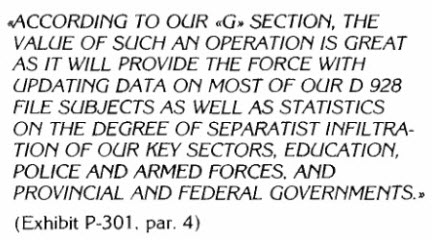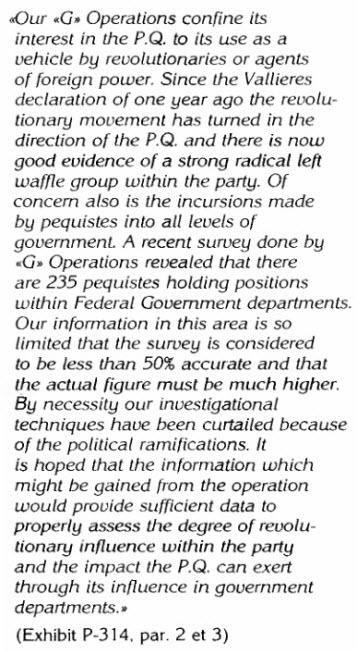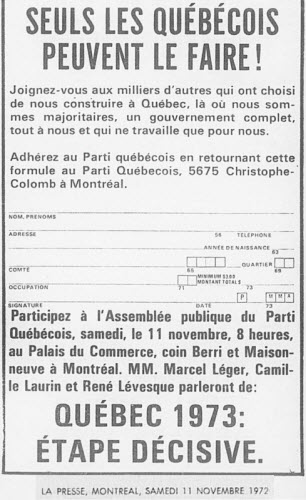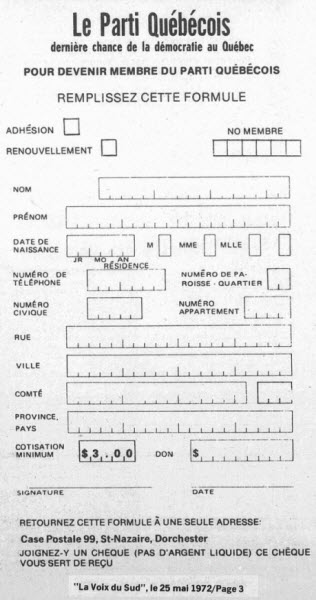Operation Ham, is the code name, for a clandestine operation, which allowed the RCMP (Royal Canadian Mounted Police), to break into a computer center, at 9820 Jeanne-Mance, Montreal, in the early hours of the morning of January 9, 1973, and to seize computer tapes, which contained, the members list, of the Parti Québécois, a legal and sovereigntist, social democratic party, with seats in the National Assembly of Quebec, as well as information about them, such as their professions and addresses, the tapes were copied, and returned, few hours later, on the same night, to the place, where they were taken, from.
The objectives of operation ham, according to RCMP documents, and to the testimony, of John Starnes, the former director general, of the RCMP Security Service, before the Keable commission:
- know the degree of separatist infiltration, in the key sectors, education, police and armed forces, as well as, the provincial and federal governments. A survey done by G section, revealed, that there are 235 Pequistes, holding positions, within Federal Government departments, the survey is considered not to be accurate, and that the actual figure, was much higher.
- There is evidence of the existence, within the Party Québécois, of a strong radical left current, assess, the degree of revolutionary influence, within the party.
- find out, if the Parti Quebecois, has received $350,000, from a foreign power, more specifically France, and measure the influence of foreign powers, on the evolution, of the Parti Québécois.


The plan to steal the membership list, of the Parti Quebecois, was first formulated, in a report by Corporal Maurice Goguen, of the "G" Section, which was created by the RCMP, to deal, with separatist movements, and terrorist activities, in Quebec.
Goguen, informed in his report, of the membership form, of the Parti Québecois, which he has spotted in an ad, promoting, the Parti Québecois, membership. The membership form, collected information such as, level of education, occupation, employer, date of birth, name, address, and phone number.


Goguen also reported, that the membership records, were stored on computer storage tapes, in a computer center, located at, 9820 Jeanne-Mance.
Goguen recommended, to consult R.E. Meyer, the officer in charge, of the software and operations branch, for the RCMP's Canadian Police Information Centre, for the ways and possibilities, of gaining access, to the information, that the Parti Québecois, has on computer.
James Emberg, a former member of the RCMP, who worked in a company, which had, a business relationship, with the targeted company, was approached, for assistance.
Emberg, arranged a visit to the location, on October 18 1972, and accompanied Ken Burnett, an RCMP computer expert, who used the alias, ken burns. Ken Burns cover story, was that he represented a trucking company, interested in doing business, and a manager of a trucking company, who was a friend of an RCMP agent, agreed to back up the story, if necessary.
The visit, provided an opportunity, to survey the building, and the second phase of the operation, was characterized by, surveillance, collection of information, and simulations, of the operation itself.
On November 21, Staff Sergeant Gilbert Albert, and Corporal Dale Boire, of the RCMP, met with Albert Pinet, the owner of the company, which installed the alarm system, at 9820 Jeanne-Mance. This time, the cover story, was investigating a pornography ring, and Pinet, provided the RCMP agents, the code, to disconnect the alarm, and keys, he had, for the lock.
The operation took place, in the early hours, of the morning, of January 9, 1973, four members of the RCMP broke into the computer center, removed the Parti Québécois tapes, copied them in another location, and returned them, at around 5:15, in the morning. The copied tapes, were subsequently moved, to Ottawa, and it was decided, that the information collected from the analysis of the members list, was to be written down, as reports, from human sources.
On July 7, 1975, the tapes and their printout, but not the information collected from the analysis, were destroyed, the content was dated, but, still delicate, and it can be embarrassing, for the government and the RCMP, if it fell, in the wrong hands.
